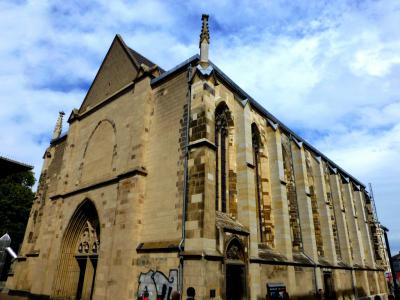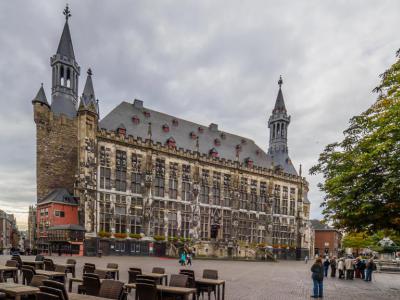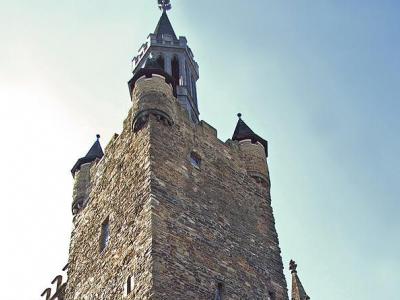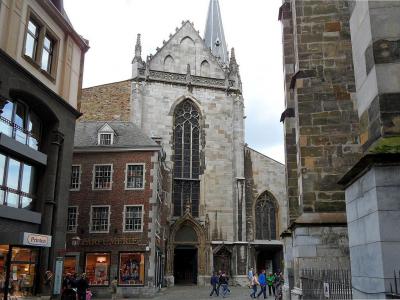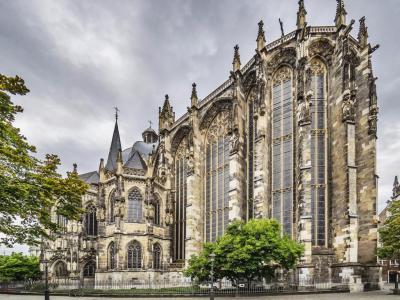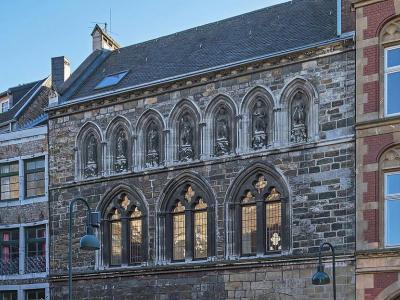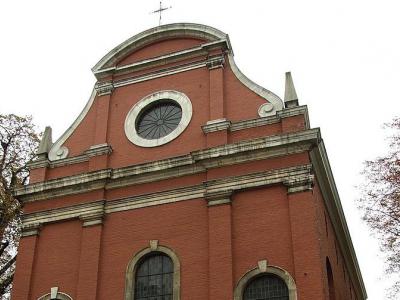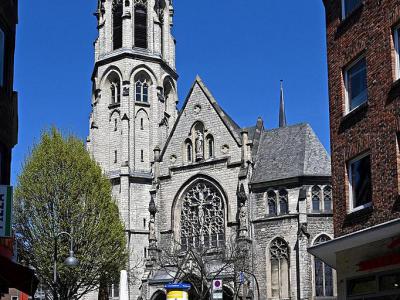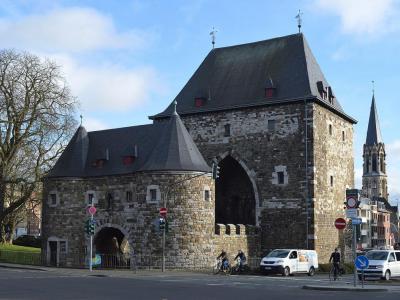
Aachen's Historical Buildings Tour (Self Guided), Aachen
Evolved from an ancient Roman settlement, Aachen is one of the oldest and most historic cities in Germany. At one time it served as the capital of Holy Roman Empire. Today's Aachen is just a small city yet with a very rich history and stunning architecture. Despite being heavily damaged during World War II, some of its historical buildings have survived to our days courtesy of the strenuous reconstruction effort started almost immediately after the war.
As the royal residence of the emperor Charlemagne, Aachen was the principal coronation site of Holy Roman emperors and German kings from the Middle Ages to the Reformation. The Palatine Chapel, a masterpiece of the distinctive Carolingian architecture, incorporated within Aachener Dom (Aachen Cathedral), was designated a UNESCO World Heritage site in 1978. The Cathedral itself, an eye-catching monument to Europe's illustrious past, is a fine mix of Carolingian and Gothic styles. Luckily, it suffered relatively little damage during WWII, and is currently one of the most influential buildings on the continent – architecturally, historically and religiously.
Also noteworthy are the well-preserved medieval churches such as St Foillan and St Nicholas, as well as the Rathaus (Town Hall), a wonderful stately edifice constructed circa 1530 on the ruins of Charlemagne’s palace and containing the magnificent Hall of the Emperors. Its renown was so great that later many town halls throughout Medieval Europe were modeled on it. Another monument still extant, originally a portion of the Charlemagne imperial palace, is the Granusturm (Granus Tower).
One more relic from the times when Aachen was a Free Imperial City is the Ponttor, a 14th-century gate once manned by soldiers, now used by German Youth and Scout groups.
There are quite a few historical buildings in Aachen where you can learn much about the city's glorious past. To explore the most spectacular of them in your good time and at your own pace, take this self-guided walking tour.
As the royal residence of the emperor Charlemagne, Aachen was the principal coronation site of Holy Roman emperors and German kings from the Middle Ages to the Reformation. The Palatine Chapel, a masterpiece of the distinctive Carolingian architecture, incorporated within Aachener Dom (Aachen Cathedral), was designated a UNESCO World Heritage site in 1978. The Cathedral itself, an eye-catching monument to Europe's illustrious past, is a fine mix of Carolingian and Gothic styles. Luckily, it suffered relatively little damage during WWII, and is currently one of the most influential buildings on the continent – architecturally, historically and religiously.
Also noteworthy are the well-preserved medieval churches such as St Foillan and St Nicholas, as well as the Rathaus (Town Hall), a wonderful stately edifice constructed circa 1530 on the ruins of Charlemagne’s palace and containing the magnificent Hall of the Emperors. Its renown was so great that later many town halls throughout Medieval Europe were modeled on it. Another monument still extant, originally a portion of the Charlemagne imperial palace, is the Granusturm (Granus Tower).
One more relic from the times when Aachen was a Free Imperial City is the Ponttor, a 14th-century gate once manned by soldiers, now used by German Youth and Scout groups.
There are quite a few historical buildings in Aachen where you can learn much about the city's glorious past. To explore the most spectacular of them in your good time and at your own pace, take this self-guided walking tour.
How it works: Download the app "GPSmyCity: Walks in 1K+ Cities" from Apple App Store or Google Play Store to your mobile phone or tablet. The app turns your mobile device into a personal tour guide and its built-in GPS navigation functions guide you from one tour stop to next. The app works offline, so no data plan is needed when traveling abroad.
Aachen's Historical Buildings Tour Map
Guide Name: Aachen's Historical Buildings Tour
Guide Location: Germany » Aachen (See other walking tours in Aachen)
Guide Type: Self-guided Walking Tour (Sightseeing)
# of Attractions: 9
Tour Duration: 1 Hour(s)
Travel Distance: 1.7 Km or 1.1 Miles
Author: leticia
Sight(s) Featured in This Guide:
Guide Location: Germany » Aachen (See other walking tours in Aachen)
Guide Type: Self-guided Walking Tour (Sightseeing)
# of Attractions: 9
Tour Duration: 1 Hour(s)
Travel Distance: 1.7 Km or 1.1 Miles
Author: leticia
Sight(s) Featured in This Guide:
- St. Nicholas Church
- Rathaus (Town Hall)
- Granus Tower
- St. Foillan’s Church
- Aachener Dom (Aachen Cathedral)
- Grashaus (Grass House)
- St. Theresa's Church
- Holy Cross Church
- Ponttor Gate
1) St. Nicholas Church
The first records of a church on this site go back to 1005. It was dedicated to Nicholas of Myra.
Around 1222, brothers of the Franciscan order took over the chapel and built a new monastery. The brothers rebuilt the existing structure to suit their needs, building a gothic-style church. Unfortunately, the building was damaged by a fire in 1333, but the order was popular and expanded rapidly during the 14th century. They used the building until it came to be in disrepair in the early 17th century.
The foundation stones for the new building--the one you see today--were laid in 1630. Over the centuries, however, numerous fires and war damage have resulted in constant reconstructions. The last major construction was in 1951, repairing World War II damage.
Monasteries were dissolved during the secularization movement of the early 19th century. The French removed the altarpieces and sent them to the Louvre in Paris, and they used the building for wounded soldiers and horse stables. The other monastery buildings were turned into a prison. It was only because St. Nicholas had been declared a parish church that it did not get completely destroyed.
Today, St. Nicholas is the city church of Aachen. A Protestant and Catholic association was founded in 2001 to oversee the church's operation. Many cultural events are held in the building. The Aachen Symphony Orchestra and several choirs have performed and recorded here.
Around 1222, brothers of the Franciscan order took over the chapel and built a new monastery. The brothers rebuilt the existing structure to suit their needs, building a gothic-style church. Unfortunately, the building was damaged by a fire in 1333, but the order was popular and expanded rapidly during the 14th century. They used the building until it came to be in disrepair in the early 17th century.
The foundation stones for the new building--the one you see today--were laid in 1630. Over the centuries, however, numerous fires and war damage have resulted in constant reconstructions. The last major construction was in 1951, repairing World War II damage.
Monasteries were dissolved during the secularization movement of the early 19th century. The French removed the altarpieces and sent them to the Louvre in Paris, and they used the building for wounded soldiers and horse stables. The other monastery buildings were turned into a prison. It was only because St. Nicholas had been declared a parish church that it did not get completely destroyed.
Today, St. Nicholas is the city church of Aachen. A Protestant and Catholic association was founded in 2001 to oversee the church's operation. Many cultural events are held in the building. The Aachen Symphony Orchestra and several choirs have performed and recorded here.
2) Rathaus (Town Hall) (must see)
Aachen Town Hall is located between two of the town's primary squares--Market Square and Katschhof Square. The building is from the early 14th century, and it's still the seat of the mayor and city council. In those days, the hall was the location of the coronation feast, part of the ceremony that went along with the coronation of a new Holy Roman Emperor at the cathedral. Between 936 to 1531, 31 emperors of Holy Roman Empire were crowned in Aachen.
The building was built upon parts of the original Palace of Aachen built during the Carolingian dynasty. You can see elements and masonry from the era of Charlemagne incorporated into the south wall.
Over the years, several fires have damaged the building. The resulting reconstruction has changed and updated the look of the building. For example, after the Great Fire of Aachen in 1656, the destroyed roof and towers were replaced with baroque elements. The 18th century saw many other gothic adornments removed as the building was further updated in the trendy baroque style.
After the Napoleonic era, the building fell into disrepair. In the 19th century, Chief Architect Friedrich Joseph Ark began rebuilding--this time in the neogothic style to return the building to its original state. Frescoes were added that depicted the legends of Charlemagne. In addition, the sides of the building were adorned with statues of 50 kings and symbols of science, art, and Christianity.
Bombing raids in World War II damaged the building. The building burned with such heat that the steel skeletons of the tower caps twisted. The complete collapse of the building was only prevented thanks to makeshift emergency beams. It wasn't until the late 1960s that a plan was formed to rebuild the towers.
Charlemagne has often been called Father of Europe. Today the Charlemagne Prize is awarded at this location. The prize is awarded to individuals who have made strides towards a more unified Europe. Previous recipients include Pope John Paul II, US President Bill Clinton, and German Chancellor Angela Merkel.
The building was built upon parts of the original Palace of Aachen built during the Carolingian dynasty. You can see elements and masonry from the era of Charlemagne incorporated into the south wall.
Over the years, several fires have damaged the building. The resulting reconstruction has changed and updated the look of the building. For example, after the Great Fire of Aachen in 1656, the destroyed roof and towers were replaced with baroque elements. The 18th century saw many other gothic adornments removed as the building was further updated in the trendy baroque style.
After the Napoleonic era, the building fell into disrepair. In the 19th century, Chief Architect Friedrich Joseph Ark began rebuilding--this time in the neogothic style to return the building to its original state. Frescoes were added that depicted the legends of Charlemagne. In addition, the sides of the building were adorned with statues of 50 kings and symbols of science, art, and Christianity.
Bombing raids in World War II damaged the building. The building burned with such heat that the steel skeletons of the tower caps twisted. The complete collapse of the building was only prevented thanks to makeshift emergency beams. It wasn't until the late 1960s that a plan was formed to rebuild the towers.
Charlemagne has often been called Father of Europe. Today the Charlemagne Prize is awarded at this location. The prize is awarded to individuals who have made strides towards a more unified Europe. Previous recipients include Pope John Paul II, US President Bill Clinton, and German Chancellor Angela Merkel.
3) Granus Tower
The Granusturm is a monument in Aachen and was originally built as part of Charlemagne 's imperial palace. The roughly 20 meter high tower, made of quarry stone, was completed in AD 788. The sides of the square building measure 8.85 meters. Today, the Granusturm is one of Aachen 's two town hall towers, along with the Marktturm. According to the current state of research, it was named after the Celtic god of healing Grannus (cf. also Aquae Granni ).
There is a vaulted room on each of three floors. Stairs between the interior walls and the exterior masonry connect the floors. A water-flushed latrine was installed in a vaulted room on the ground floor.
The function of the tower is so far unclear and is currently the subject of research. Previous assumptions that the building temporarily served as a residential tower for Charlemagne's family seem to have no substance. The building could not be heated, there were no sanitary facilities on the upper floors and the lighting conditions are insufficient, since the only small windows were covered with thinly scraped and greased animal skins in iron window frames to protect against rain or snow during the cold season.
The tower is currently assigned the function of a stairwell. This made it possible to climb to the upper floor of the porch of the King's Hall and thus the transition to an adjacent (late antique) fortification wall that ran in a circle around the market hill, and thus to possible other buildings attached to this ring wall. Corridors lead into the basement of the tower, some of which are now buried and walled up.
There is a vaulted room on each of three floors. Stairs between the interior walls and the exterior masonry connect the floors. A water-flushed latrine was installed in a vaulted room on the ground floor.
The function of the tower is so far unclear and is currently the subject of research. Previous assumptions that the building temporarily served as a residential tower for Charlemagne's family seem to have no substance. The building could not be heated, there were no sanitary facilities on the upper floors and the lighting conditions are insufficient, since the only small windows were covered with thinly scraped and greased animal skins in iron window frames to protect against rain or snow during the cold season.
The tower is currently assigned the function of a stairwell. This made it possible to climb to the upper floor of the porch of the King's Hall and thus the transition to an adjacent (late antique) fortification wall that ran in a circle around the market hill, and thus to possible other buildings attached to this ring wall. Corridors lead into the basement of the tower, some of which are now buried and walled up.
Sight description based on Wikipedia.
4) St. Foillan’s Church
The pedestrian zone in the heart of Aachen houses the parish church of St Foillan. This is the only church in the German-speaking world that is dedicated to this Irish saint (also known as Faelan, Feuillien, Faolan, Foelan, Feuillen de Fosses, or Pholien), which in itself is an indication that the proselytization of the Aachen area came from the west.
At some point, the expansion of nearby Aachen Cathedral brought the two temples close together, separated only by a narrow alley. The first church on this site, bearing the same name, was built around 1180 (one of the oldest parish churches in the city). Erected in its place three-nave Gothic temple was consecrated in 1482; some parts of it have survived to this day.
The current church retains very little of its original appearance; only fragments of the choir, parts of the façade and few other features have survived. The rest of the façade, much as the church's tower, date from 1888 or later. A bomb attack in 1944 almost completely destroyed the building.
From 1956 to 1958, the church was reconstructed, during which the preserved Gothic parts were reassembled using the latest construction technology.
The main eye-catcher on the inside, found in the middle of the choir, is the altar from 1962, made of blue stone. The surrounding relief depicts 32 scenes from the story of Salvation. Above the altar is a large bronze crucifix with enamel coating (also from 1962) with the scenes of Crucifixion on the front and the Lamb of God on the back. Among the most notable sculptures at St Foillan is the Beautiful (or Soft-) style Madonna, made in 1410 and named so for its distinctively soft, elegant forms.
At some point, the expansion of nearby Aachen Cathedral brought the two temples close together, separated only by a narrow alley. The first church on this site, bearing the same name, was built around 1180 (one of the oldest parish churches in the city). Erected in its place three-nave Gothic temple was consecrated in 1482; some parts of it have survived to this day.
The current church retains very little of its original appearance; only fragments of the choir, parts of the façade and few other features have survived. The rest of the façade, much as the church's tower, date from 1888 or later. A bomb attack in 1944 almost completely destroyed the building.
From 1956 to 1958, the church was reconstructed, during which the preserved Gothic parts were reassembled using the latest construction technology.
The main eye-catcher on the inside, found in the middle of the choir, is the altar from 1962, made of blue stone. The surrounding relief depicts 32 scenes from the story of Salvation. Above the altar is a large bronze crucifix with enamel coating (also from 1962) with the scenes of Crucifixion on the front and the Lamb of God on the back. Among the most notable sculptures at St Foillan is the Beautiful (or Soft-) style Madonna, made in 1410 and named so for its distinctively soft, elegant forms.
Sight description based on Wikipedia.
5) Aachener Dom (Aachen Cathedral) (must see)
The Aachen Cathedral is one of the oldest in Europe. It was constructed on the orders of Charlemagne in 796. The finished building, then known as the Palatine Chapel, was consecrated by Pope Leo III in 805. Charlemagne was buried in the chapel in 814.
Antipope Paschal III canonized Charlemagne in 1165, and the chapel began drawing pilgrims from all over Europe. The traffic spawned a burst of construction activity over the next 700 years, with the choir hall, glass chapel, cupola, and steeple all being added.
Like the rest of the city, bombs heavily damaged the cathedral during World War II. Thankfully, however, the basic structure survived, and its art treasures had been previously removed for safe keeping. Bringing the cathedral back to its former glory was a 30-year, 40-million-Euro project.
The core building of the cathedral is the Carolingian Octagon, or Palatine Chapel. It was built based on the Byzantine buildings of the time. The domed octagonal interior was designed by architect Odo of Metz, the earliest known architect north of the Alps.
The upper gallery is divided by ancient columns. These came from St. Gereon in Cologna, spolia Charlemagne brought to Aachen from Rome during the eighth century.
The geometry of the Carolingian Octagon is equally fascinating. Researchers have traced a previously unknown unit of measurement back to the structure--322.4 mm. This has come to be known as the Carolingian foot.
The eight sides of the octagon symbolize the eighth day and the resurrection of Jesus. Ten is also a reoccurring number in the structure since it symbolized perfection in Medieval architecture. For example, the diameter of the building is 100 (10 x 10) Carolingian feet, as is the dome's height.
Notable items in the cathedral include Charlemagne's throne, the Shrine of St. Mary, the Barbarossa chandelier, and the Pala d'Oro. The church served as the coronation church for German kings for over 500 years. The precise final resting place of Charlemagne is unknown, but it is believed to be in the Persephone sarcophagus under the west tower. The actual sarcophagus is now part of the Cathedral Treasury's collection.
Antipope Paschal III canonized Charlemagne in 1165, and the chapel began drawing pilgrims from all over Europe. The traffic spawned a burst of construction activity over the next 700 years, with the choir hall, glass chapel, cupola, and steeple all being added.
Like the rest of the city, bombs heavily damaged the cathedral during World War II. Thankfully, however, the basic structure survived, and its art treasures had been previously removed for safe keeping. Bringing the cathedral back to its former glory was a 30-year, 40-million-Euro project.
The core building of the cathedral is the Carolingian Octagon, or Palatine Chapel. It was built based on the Byzantine buildings of the time. The domed octagonal interior was designed by architect Odo of Metz, the earliest known architect north of the Alps.
The upper gallery is divided by ancient columns. These came from St. Gereon in Cologna, spolia Charlemagne brought to Aachen from Rome during the eighth century.
The geometry of the Carolingian Octagon is equally fascinating. Researchers have traced a previously unknown unit of measurement back to the structure--322.4 mm. This has come to be known as the Carolingian foot.
The eight sides of the octagon symbolize the eighth day and the resurrection of Jesus. Ten is also a reoccurring number in the structure since it symbolized perfection in Medieval architecture. For example, the diameter of the building is 100 (10 x 10) Carolingian feet, as is the dome's height.
Notable items in the cathedral include Charlemagne's throne, the Shrine of St. Mary, the Barbarossa chandelier, and the Pala d'Oro. The church served as the coronation church for German kings for over 500 years. The precise final resting place of Charlemagne is unknown, but it is believed to be in the Persephone sarcophagus under the west tower. The actual sarcophagus is now part of the Cathedral Treasury's collection.
6) Grashaus (Grass House)
Grashaus is not only one of the oldest buildings in the city, but also historically significant as Aachen's first town hall. It was completed in 1267, but probably stands on even older foundations, possibly from the Carolingian period. The grass house owes its name to the grass, a medieval village green on which executions as well as public festivals and allegedly the burials of the executed took place.
The building came at a time of social change. From the 12th century, the aspiring citizens, who had become rich through trade and the manufacture of cloth, increasingly demanded a say in the affairs of the emperors and kings ruling in Aachen. On January 8, 1166, city rights were granted by Emperor Friedrich I, Barbarossa and, on the basis of the so-called Charlemagne privilege, all residents were freed from feudal servitude and exempted from customs duties in the Aachen Empire. From the year 1250, a city council headed by two mayors finally took over the administrative business of the royal lay judges, who from then on were mainly responsible for the jurisdiction.
The associated construction of a town hall, burgerhuys, also known as domus civium and burger grass, also had a symbolic character and at the same time was an expression of the self-confidence of an aspiring citizenry. This construction was also approved by King Richard of Cornwall, who was crowned in Aachen in 1257 and who shared in the costs with a generous financial donation.
The building came at a time of social change. From the 12th century, the aspiring citizens, who had become rich through trade and the manufacture of cloth, increasingly demanded a say in the affairs of the emperors and kings ruling in Aachen. On January 8, 1166, city rights were granted by Emperor Friedrich I, Barbarossa and, on the basis of the so-called Charlemagne privilege, all residents were freed from feudal servitude and exempted from customs duties in the Aachen Empire. From the year 1250, a city council headed by two mayors finally took over the administrative business of the royal lay judges, who from then on were mainly responsible for the jurisdiction.
The associated construction of a town hall, burgerhuys, also known as domus civium and burger grass, also had a symbolic character and at the same time was an expression of the self-confidence of an aspiring citizenry. This construction was also approved by King Richard of Cornwall, who was crowned in Aachen in 1257 and who shared in the costs with a generous financial donation.
Sight description based on Wikipedia.
7) St. Theresa's Church
The Theresienkirche is a Catholic church formerly affiliated to the Carmel of St. Theresa of Avila. The church was built between 1739 and 1745 by Laurenz Mefferdatis; the Baroque architect Johann Joseph Couven designed the interior. As part of secularization, the building became municipal property in 1802.
In 1943 the Theresienkirche burned down. To avoid fire hazard in case of an attack during WWII, the altars, communion rails, pulpit and 18th-century wall paneling had been removed and dumped into a castle moat. In 1945 it was still possible to salvage them, but the weather elements had affected the wooden items so badly that they could only be used as a model for future reconstruction.
In the 1950s, the church was rebuilt to appear like it was back in the 18th century; the furnishings, however, were restored only in the 1970s.
The Neoclassical brick edifice has a three-axis structure divided by pilasters with an arched window and a segmented gable. The structure follows the course of the street that had already existed in the 18th century and was therefore not built in the typical east-west orientation.
By inserting a triangular staircase, Mefferdatis succeeded in realizing a rectangular interior floor plan. The single-nave hall is vaulted with three bays. The choir is located behind a high triumphal arch.
The columned main altar with gilded Corinthian capitals is made of oak. The Rococo carvings of two angels decorate the tabernacle. The entire interior decoration was donated by Johann von Wespien in 1754, whose sister was the reverend mother of the convent, Maria Anna van Wespien. Their coats of arms are seen above the paintings in the altar, between the two palm leaves, reminding of the donation made.
Presently, the church is used by the Romanian Orthodox congregation of the Holy Trinity.
In 1943 the Theresienkirche burned down. To avoid fire hazard in case of an attack during WWII, the altars, communion rails, pulpit and 18th-century wall paneling had been removed and dumped into a castle moat. In 1945 it was still possible to salvage them, but the weather elements had affected the wooden items so badly that they could only be used as a model for future reconstruction.
In the 1950s, the church was rebuilt to appear like it was back in the 18th century; the furnishings, however, were restored only in the 1970s.
The Neoclassical brick edifice has a three-axis structure divided by pilasters with an arched window and a segmented gable. The structure follows the course of the street that had already existed in the 18th century and was therefore not built in the typical east-west orientation.
By inserting a triangular staircase, Mefferdatis succeeded in realizing a rectangular interior floor plan. The single-nave hall is vaulted with three bays. The choir is located behind a high triumphal arch.
The columned main altar with gilded Corinthian capitals is made of oak. The Rococo carvings of two angels decorate the tabernacle. The entire interior decoration was donated by Johann von Wespien in 1754, whose sister was the reverend mother of the convent, Maria Anna van Wespien. Their coats of arms are seen above the paintings in the altar, between the two palm leaves, reminding of the donation made.
Presently, the church is used by the Romanian Orthodox congregation of the Holy Trinity.
Sight description based on Wikipedia.
8) Holy Cross Church
The Pfarrkirche Heilig Kreuz (Holy Cross Church) on Aachen's Pontstraße, near the Ponttor gate, is the third church on this site, and was consecrated in 1902. Laying its foundation stone in 1898 was preceded by a lengthy dispute, as to where it should stand; so long in fact that the pastor had resigned and only the radical actions of his successor made it possible to “set the ball rolling”.
The very first chapel on the spot, rather modest in size, also took quite a long time to build, from 1363 to 1372. Later, the original structure was rebuilt several times. During the fire in 1656, it was destroyed down to the outer walls and was fully restored only in 1770, hampered by the wars and periods of unrest.
The architect Joseph Buchkremer planned the current church in the spirit of historicism, combining German and French High Gothic elements. The public accused him of arbitrariness in the choice of stylistic elements, yet today the Heilig-Kreuz-Kirche remains one of the few churches in Aachen with an almost authentic historic church interior.
The building is a cross-shaped, three-aisled basilica with a short nave, which creates the impression of a temple surrounded by chapels. Resorting to this construction form was dictated by the limited space available.
The single tower in the northern part of the church, a component of German High Gothic, is particularly striking. Another point of interest is the Sacrament Chapel, located on the site of the former Julian Chapel. The capitals of the round columns of the church, supporting the ribbed vault, are decorated with vine leaves and foliage.
The façade consists of a vestibule with three portals, surmounted by a large window with a stone crucifix and the statues of the Virgin Mary and John the Baptist. The text on the façade reads "Stat crux, dum volvitur orbis " (The cross stands firm while the world turns) which is originally the motto of the Carthusians. In the upper part of the façade is a statue of Saint Helena.
Inside, the church contains numerous art treasures spanning the 15th through 20th centuries. Among them the most noteworthy is a silver chalice with Gothic ornamentation (dating from the late 15th century), gilded and with small enamel decorations, including a Latin text engraved with the names of the donors.
The very first chapel on the spot, rather modest in size, also took quite a long time to build, from 1363 to 1372. Later, the original structure was rebuilt several times. During the fire in 1656, it was destroyed down to the outer walls and was fully restored only in 1770, hampered by the wars and periods of unrest.
The architect Joseph Buchkremer planned the current church in the spirit of historicism, combining German and French High Gothic elements. The public accused him of arbitrariness in the choice of stylistic elements, yet today the Heilig-Kreuz-Kirche remains one of the few churches in Aachen with an almost authentic historic church interior.
The building is a cross-shaped, three-aisled basilica with a short nave, which creates the impression of a temple surrounded by chapels. Resorting to this construction form was dictated by the limited space available.
The single tower in the northern part of the church, a component of German High Gothic, is particularly striking. Another point of interest is the Sacrament Chapel, located on the site of the former Julian Chapel. The capitals of the round columns of the church, supporting the ribbed vault, are decorated with vine leaves and foliage.
The façade consists of a vestibule with three portals, surmounted by a large window with a stone crucifix and the statues of the Virgin Mary and John the Baptist. The text on the façade reads "Stat crux, dum volvitur orbis " (The cross stands firm while the world turns) which is originally the motto of the Carthusians. In the upper part of the façade is a statue of Saint Helena.
Inside, the church contains numerous art treasures spanning the 15th through 20th centuries. Among them the most noteworthy is a silver chalice with Gothic ornamentation (dating from the late 15th century), gilded and with small enamel decorations, including a Latin text engraved with the names of the donors.
Sight description based on Wikipedia.
9) Ponttor Gate
The Ponttor (known in the 17th and 18th centuries as the Brückenpforte or Brückenthor) is one of the two remaining gates of the original medieval wall of Aachen (the other being the Marschiertor), and as such is a prominent landmark in the city. The westernmost of the north-facing gates, it was built in 1320, designed for defense purposes, and was originally manned by soldiers and militia throughout Aachen's Free Imperial City era.
The name Ponttor is assumed to be derived from the Latin word "pons", which means bridge. Although indeed, Aachen has several rivers and streams passing through, none of them is found nearby. Still, before the gate appeared, the area itself had already carried this appellation, so the gate must have been named after the neighborhood itself. The latter was named after a bridge that existed in Roman times on what is now known as the Annuntiaten stream. Beyond this area lay extensive swamps, and to exit the settlement, one would have to cross the bridge.
The Ponttor is a right-angled, three-storey gateway with two small towers and the main portal in between. In the main entrance, there is a Portcullis as well as a machicolation, through which things could be dropped onto the invading enemy. A bridge passage with crenelations spanned a moat and was strengthened in the foregate with two reinforced towers (barbicans). The building material was Devonian sandstone, with the framing made of light bluestone.
At the top of the main gate’s arch is the statue of the Virgin, protector of the city.
Today, the Ponttor is used by German Youth and Scout groups belonging to the German Scout Club (1945) and the German Scout Association of Saint George.
The name Ponttor is assumed to be derived from the Latin word "pons", which means bridge. Although indeed, Aachen has several rivers and streams passing through, none of them is found nearby. Still, before the gate appeared, the area itself had already carried this appellation, so the gate must have been named after the neighborhood itself. The latter was named after a bridge that existed in Roman times on what is now known as the Annuntiaten stream. Beyond this area lay extensive swamps, and to exit the settlement, one would have to cross the bridge.
The Ponttor is a right-angled, three-storey gateway with two small towers and the main portal in between. In the main entrance, there is a Portcullis as well as a machicolation, through which things could be dropped onto the invading enemy. A bridge passage with crenelations spanned a moat and was strengthened in the foregate with two reinforced towers (barbicans). The building material was Devonian sandstone, with the framing made of light bluestone.
At the top of the main gate’s arch is the statue of the Virgin, protector of the city.
Today, the Ponttor is used by German Youth and Scout groups belonging to the German Scout Club (1945) and the German Scout Association of Saint George.
Sight description based on Wikipedia.
Walking Tours in Aachen, Germany
Create Your Own Walk in Aachen
Creating your own self-guided walk in Aachen is easy and fun. Choose the city attractions that you want to see and a walk route map will be created just for you. You can even set your hotel as the start point of the walk.
Aachen Introduction Walking Tour
The area that is now home to Aachen has been occupied since at least Neolithic times. The mineral springs have drawn people here for eons, and historians have found evidence of settlements from the Bronze and Iron Ages. In those days, the area was settled by the Celtic peoples. They probably came here to worship Grannus, god of light and healing.
The Romans built the town as a spa resort... view more
Tour Duration: 1 Hour(s)
Travel Distance: 1.4 Km or 0.9 Miles
The Romans built the town as a spa resort... view more
Tour Duration: 1 Hour(s)
Travel Distance: 1.4 Km or 0.9 Miles
The Most Popular Cities
/ view all
